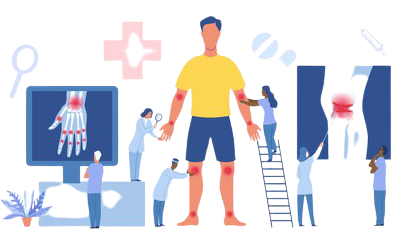Hand pain treatment online | Online Physiotherapy Clinic
- Affordable and reliable hand pain treatment
- Video sessions with expert Physiotherapists/ PTs.
- Specialized physical therapy for hand pain, sprain, bursitis, or stiffness
Begin Therapy
Consult online with best Physios
A New Model for Hand Pain treatment
We understand that it’s difficult for most of us to find time for traditional Hand physical therapy. Physio Mantra brings to you online hand pain treatment, where all hand exercises and treatments are managed through regular online check-ins & video sessions.
Expert Physical Therapists
Physio Mantra members get matched with a professional physiotherapist for one-on-one hand pain treatment. They use interactive exercise videos available on our app to treat you.
Continuous Medical Care
Physio Mantra physiotherapists are 100% virtual and provide physical therapy to patients without any time and geographical barriers. Our technology-enabled approach helps manage physical ailments from head to toe.
Personalized hand Therapy
Physio Mantra provides everyday exercises, home remedies, and regular check-ins for all your hand pain physiotherapy needs. We individualize treatment for each person, with problems including hand pain, muscle injuries, sprain, bursitis, stiffness, and more.

Best Hand Pain Clinic, Now In Your Pocket
Our physical therapists or PTs are available in all parts of the world via an easy-to-use mobile application. The use of artificial intelligence, and data science enables the patients to connect with expert physiotherapists and get real-time insights into their hand health. Download PhysioMantra App Now

How it works

Signup for our Hand Treatment Program
Just fill up a 5-minute online form to tell us about your hand pain history and treatment expectations.

Meet your PT
We will connect you with a physiotherapist who is available 24/7 to you via call or chat.

Connect to our app
Get Physical Therapy sessions on our app via video calls. Follow exercises suggested by our PT and track your progress in the app.
Meet the best online physical therapist
MantraCare physical therapists treat muscle and joint pain problems through a combination of body exercises, video demonstrations, and a healthy diet. Our treatment experience is a better traditional in-person approach in multiple ways.

Dedicated Physio
You get a personal Physio who customizes the exercise plan based on your comfort and needs

App-guided Exercises
3D animations & voice narrations in our app ensure proper and right guidance

Expert care anywhere, anytime
With over 200+ physios, MantraCare is 100% online – no waiting rooms

Exercise Kit
Complete exercise kit with elastic bands, door anchor, and a phone stand – mailed to you
A Complete Guide About Hand Pain
Understanding Hand Pain
Hand pain is discomfort or pain in the palm and fingers. It may be caused by a malady, such as carpal tunnel syndrome, or injury to any part of the hand. Sometimes this pain is due to a disease elsewhere in the body and is felt in the hand.
This condition may affect one or both hands. The pain may be a sharp, stabbing sensation or a dull ache. It may come and go or be constant. This pain is often aggravated by using the hand or arm.
Types of Hand Pain
There are many types of hand pain. Some of the most common are:
Carpal Tunnel Syndrome
This condition is caused by pressure on the median nerve, which runs from the forearm to the hand. It results in pain, numbness, and tingling in the thumb, index finger, middle finger, and half of the ring finger.
Trigger Finger
This occurs when one of the fingers becomes stuck in a bent position. The finger may straighten with a popping sound. It is due to a narrowing of the tendons and their sheaths in the palm, which causes swelling and thickening.
Tennis Elbow or Golfers Elbow
These conditions are caused by overuse of the muscles and tend to occur at the outside of the elbow. They cause pain and tenderness along with weakness when gripping objects. It is caused by inflammation of the tendons in the forearm. Tendons connect muscle to bone.
Dupuytrens Contracture
This condition causes one or more fingers to permanently curl into a bent position. It occurs when lumps form in the palm and pull on tendons that run along with each finger, bending them down toward the palm. This disease begins as small nodules under the skin of your palm but can progress over time to thicken, tighten and shorten ligaments around joints causing contractures.
Signs of Hand Pain
There are many signs of hand pain. Some of the most common are:
Pain in the palm or fingers
This sign can vary from sharp and stabbing to a dull ache. The pain may come and go or be constant. Sometimes the pain is due to a disease elsewhere in the body and is felt in the hand.
Numbness or tingling in the thumb, index finger, middle finger, and half of the ring finger
This occurs when pressure is put on the median nerve. It results in pain, numbness, and tingling in these fingers.
Weakness when gripping objects
This can be a sign of tennis elbow or golfers elbow. These conditions are caused by overuse of muscles and tendons and occur at the outside of the elbow. They cause pain and tenderness along with weakness when gripping objects.
Contracture in one or more fingers
This condition causes one or more fingers to curl into a bent position. This may be due to Dupuytrens Contracture. This condition causes lumps to form in the palm and pulls on tendons that run along with each finger, bending them down toward the palm.
Causes of Hand Pain
There are many causes of hand pain, including:
Injury
Injury is one of the most common causes of hand pain. This can include anything from a sprain or fracture to more serious injuries such as a ruptured ligament or tendon.
Arthritis
Osteoarthritis and rheumatoid arthritis are two forms of arthritis that can cause pain and inflammation in the hands.
Repetitive Strain Injury (RSI)
RSI is a type of injury that occurs when muscles, tendons, or nerves are overused or strained. This can lead to pain, swelling, and stiffness in the hands.
Tumors
Tumors can develop in any part of the hand and can cause pain, swelling, and redness. It can also affect the range of motion in the hand.
Trigger Finger (Stenosing Tenosynovitis)
This is caused by inflammation around tendons that control finger movements causing them not to glide smoothly. This can lead to pain, stiffness, and difficulty moving the fingers.
Fractures
Sometimes some fractures can occur during sports or falls which may cause pain in the hands.
Tendonitis
This is caused by swelling and inflammation of the tendons in your hand. This can lead to pain and stiffness, especially when trying to grip objects with your hands. This condition is also known as “tennis elbow” because it often occurs in people who play tennis.
Sprain
It is common to sprain the ligaments in your hand, which can lead to pain, swelling, and difficulty using the hand. Sometimes a sprain can even cause a fracture in one of the small bones, which is called an avulsion injury.
Treatment Options For Hand Pain
There are many treatment options for hand pain. Some of the most common are:
Physical Therapy
Physical therapy is a great way to treat hand pain. Physical therapists can teach you how to properly stretch your muscles and tendons, which reduces the pressure on nerves. This will reduce symptoms such as numbness or tingling in fingers caused by carpal tunnel syndrome (CTS).
Rest
Sometimes the best treatment is simply to rest the hand. This may include avoiding activities that aggravate the condition or taking a break from work.
Ice
Applying ice to the hand can help reduce swelling and pain. Ice should be applied for fifteen minutes every two to three hours.
NSAIDs
Nonsteroidal anti-inflammatory drugs (NSAIDs) such as ibuprofen can help reduce inflammation and pain.
Corticosteroid Injections
Corticosteroid injections are used to treat carpal tunnel syndrome, tennis elbow, and golfers elbow. These injections help reduce inflammation around the affected area.
Surgery
In some cases, surgery may be necessary to treat hand pain. This includes carpal tunnel release surgery, which helps relieve pressure on the median nerve. Other surgeries include tendon repair and removal of lumps or nodules.
Physiotherapy For Hand Pain
Sometimes hand pain can be caused by something as simple as using the hand in an unusual way or overusing it. In other cases, hand pain may be a symptom of a more serious condition. Whatever the cause, there are many treatment options available to help relieve hand pain.
Physiotherapy is often recommended for hand pain. Physio can help to improve movement and function in the hand, and can also provide relief from pain and discomfort. There are many different physiotherapy techniques that can be used to treat hand pain, depending on the underlying cause.
Types of Physiotherapy For Hand Pain
There are many different types of physiotherapy that can be used to treat hand pain. Some of the most common techniques include:
Manual Therapy
Manual therapy involves the use of hands-on techniques such as massage and mobilization to improve movement. It can be beneficial in treating hand pain that is caused by stiffness or restricted movement, which may occur after an injury or surgery.
Instrument Assisted Soft Tissue Mobilisation (IASTM)
Instrument-assisted soft tissue mobilization (IASTM) uses a metal tool to treat areas of muscle tightness, tension, and scarring. A qualified physiotherapist will apply pressure with the tool over specific trigger points in order to increase blood flow and release any restrictions within the muscles or connective tissues.
Exercises For Hand Pain
Physiotherapy exercises are an important part of almost all treatment plans for hand pain, as they help to improve movement and strength in the hand. Exercises may be prescribed on their own or may be used in combination with other techniques such as manual therapy or IASTM.
Some of the most common exercises for hand pain include:
- Wrist Flexion and Extension
This exercise helps to strengthen the muscles around the wrist and increase the range of motion.
- Clench and Release
This exercise helps to improve grip strength and can be done anywhere, anytime.
- Finger Flexion and Extension
This exercise helps to improve movement in the fingers and strengthens the muscles around them.
Benefits of Physiotherapy For Hand Pain
There are many benefits to physiotherapy for hand pain. Some of these are:
Improves Movement
It can be difficult to move the hand normally when it is in pain. Physiotherapy can help to improve movement and function in the hand, which can make everyday activities much easier.
Relieves Pain and Discomfort
Pain and discomfort can be a major hindrance when trying to carry out everyday tasks. Physio can help to relieve pain and discomfort, making it easier to go about your day-to-day life.
Safer Than Surgery
Some cases of hand pain may require surgery. However, physiotherapy is often an effective alternative to surgery, with similar results.
Improves Overall Functioning
When the hand is functioning well, it allows us to do many things that we take for granted such as picking up objects, writing, or opening doors. Physiotherapy for hand pain can improve overall functioning and help to restore quality of life.
10,000+ Happy Hand Pain patients from the world

“I had surgery on my hand a few years ago and ever since then, I have been struggling with pain and stiffness. A friend recommended Physio Mantra as an alternative to surgery and it has honestly made such a difference in my life. The therapist helped me to regain movement in my hand and showed me some exercises that I can do at home to help keep the pain under control. Thanks, Physio Mantra.”
Mark, 0.5 years on MantraCare
Best physiotherapist from across the world





We treat nearly all muscle and joint issues
Not all physical or muscle problems are the same. Different types of problems require different treatments. At MantraCare, 200+ physical therapist the world cover a range of specialties to meet your needs be it back pain, shoulder pain, or sports injury:
Frequently Asked Questions
Yes, physiotherapy is a safe and effective treatment for hand pain. It is often recommended over surgery as an alternative to treatment. It is also very safe for pregnant women as there are no medications involved.
Yes, physiotherapy is an effective treatment for hand pain. It can help to relieve pain and improve movement in the hand, which may be hindered by stiffness or restricted movement. Hand exercises can also strengthen muscles around the hands and wrists so they work more efficiently when performing everyday tasks such as opening doors or typing on a keyboard.
Yes, some of the most common exercises for hand pain include wrist flexion/extension (which helps increase strength in your wrists) and clench-and-release (which improves grip strength). Both these movements can easily be performed at home without any special equipment.
Many people experience relief from hand pain after a few sessions of physiotherapy. However, the amount of time required for treatment will vary depending on the individual’s condition and the type of therapy being used.
Yes, physiotherapy can be beneficial in treating many different conditions. It is often used to treat sports injuries, postural problems, and chronic pain conditions. This is because physiotherapists have a wide range of techniques that they can use to treat physical ailments.
No, most types of physiotherapy do not hurt at all. However, some people may experience mild discomfort during certain movements or stretches if their muscles are stiff and tight from lack of use over time (this is particularly common with older adults who have arthritis in the hands). Physiotherapists will always work within your comfort zone so you never feel any pain while doing exercises for hand pain relief.
No, physiotherapy does not have any known side effects. However, as with any treatment, it is always best to speak to your therapist if you are concerned about any potential risks involved.
If you experience pain during or after physio, please consult your physiotherapist immediately. They will be able to advise you on the best course of action and may need to adjust the exercises that you are doing in order to ensure that you remain comfortable and safe while receiving treatment.











